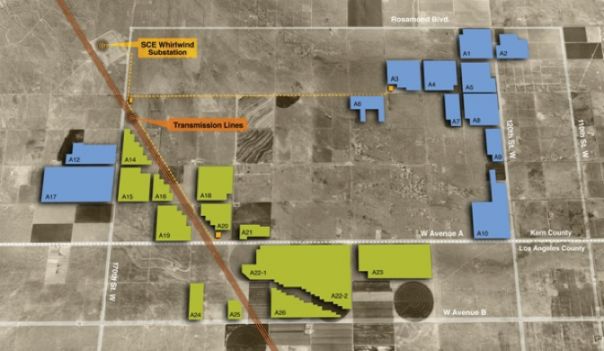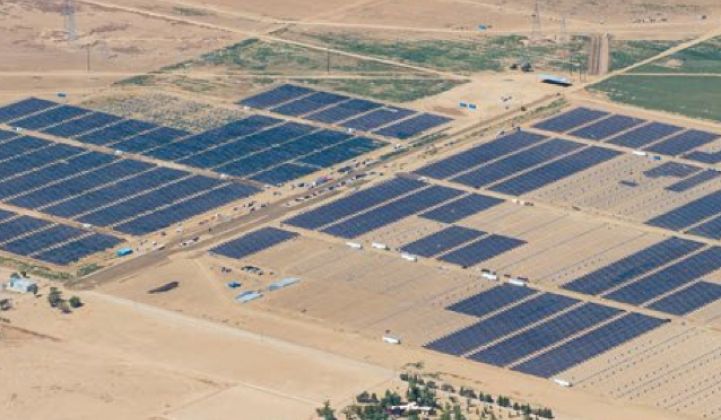BHE Renewables' 579-megawatt solar project in Antelope Valley, Calif is now fully connected to the California ISO grid. That allows the facility, dubbed "Solar Star," to claim the title of the largest operational solar project on the planet. It went fully on-line on June 19, according to the California Independent System Operator (CAISO) website.
Solar Star narrowly edges out First Solar's two projects, the 550-megawatt capacity Topaz Solar and the 550-megawatt Desert Sunlight project in Riverside, Calif. for the title.
Here's a chart showing the top three U.S. PV power plants in the U.S.
| Project Name | Developer | Capacity (MWac) | Capacity On-Line | State | Offtaker | Owner |
| Solar Star | SunPower | 579 | 579 | CA | SCE | BHE Renewables (Previously known as MidAmerican Energy Holdings) |
| Topaz Solar | First Solar | 550 | 550 | CA | PG&E | BHE Renewables (Previously known as MidAmerican Energy Holdings) |
|
Desert Sunlight |
First Solar | 550 | 550 | CA | PG&E, SCE |
NextEra Energy Resources, GE Energy Financial Services, Sumitomo |
Construction started in January 2013 on the Solar Star projects, which are sited in California's Los Angeles and Kern counties.

Below is CAISO's Master Control Area Generating Capability List.


The projects employ approximately 1.7 million SunPower monocrystalline silicon modules on single-axis trackers.
Although we may not see too many more solar projects of this size, the utility-scale solar business is alive and well.
The utility segment installed 644 megawatts in Q1 2015, according to GTM Research's U.S. Solar Market Insight report. Utility PV installations have surpassed 500 megawatts for eight consecutive quarters, according to GTM Research. GTM's Mike Munsell said, "The highlight of this quarter for the segment was not what came on-line, but instead what was procured and added to the pipeline."
The report notes that there are 25 project developers with pipelines of 100 megawatts or more. GTM Research expects a flurry of activity in the utility segment over the next 18 months ahead of the scheduled decline of the federal Investment Tax Credit.
Jim Hughes, CEO of SunPower's fellow vertically integrated solar developer First Solar, spoke at the recent Edison Electric Institute meeting in New Orleans. He said, "There's lots of talk around distributed generation, and yet the bulk of the photovoltaics added on a global basis is still utility-scale...[and] will continue to be utility-scale."
Cory Honeyman, senior solar analyst at GTM Research, weighs in: "Solar Star's completion is a milestone for the U.S. and global solar markets. It provides yet another proof of concept that mega-scale solar farms can be achieved ahead of schedule, an encouraging sign for SunPower and other leading developers' ability to finish the more than 15 gigawatts of U.S. utility PV pipeline currently in development, nearly all of which is slated for completion in 2015 or 2016.
"But Solar Star is also a ghost of U.S. solar's past, in that the project is part of a waning breed of facilities procured to meet RPS obligations rather than being based on cost-competitiveness. And SunPower, along with other leading developers, is cashing in on the new wave of centralized solar demand with the first order driver being cost."
Honeyman concludes, "We most likely will never see another project procured that's greater than 500 megawatts-AC in size, unless the California RPS is expanded to 50 percent. But there are still a number of reasons to remain bullish on the long-term growth trajectory of utility-scale solar in the U.S., fueled by incremental cost reductions that are sufficient to capitalize on new EPA carbon regulations and natural-gas price volatility."
FIGURE: Utility PV Pipeline
Source: GTM Research / SEIA U.S. Solar Market Insight report
***
Check out the GTM Research Utility PV Market Tracker for much more in-depth information about utility-scale solar deployment in the U.S.



